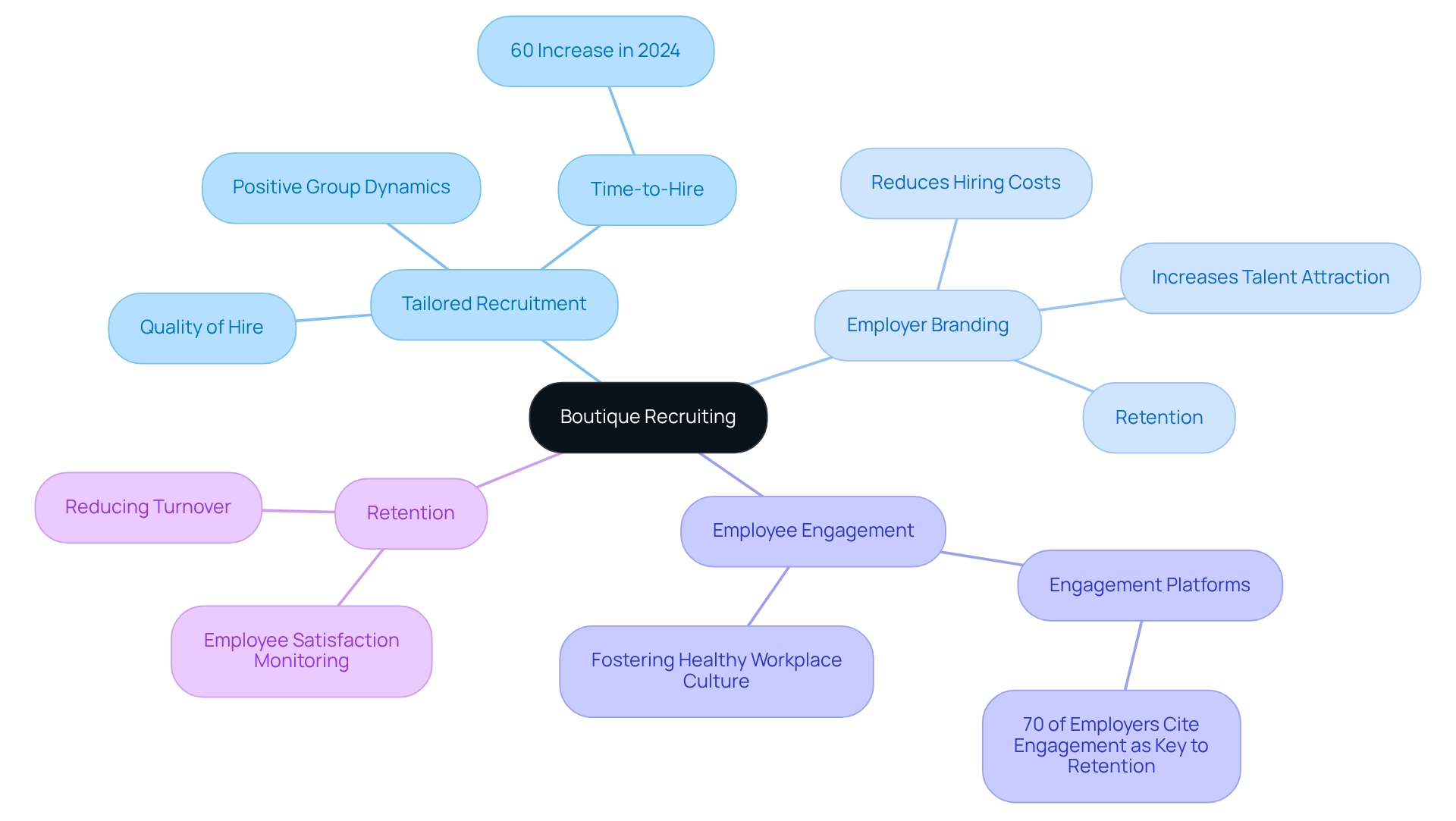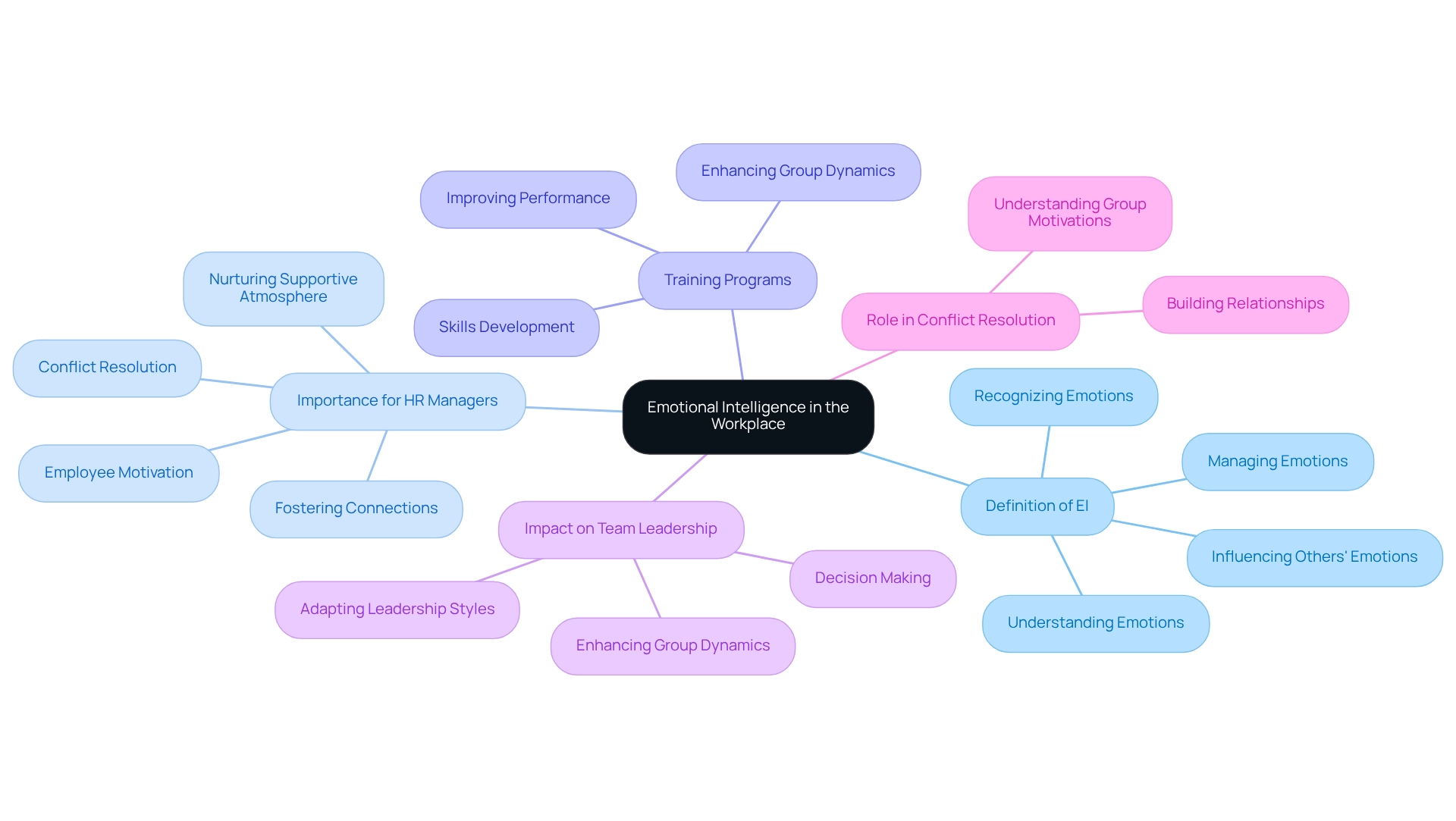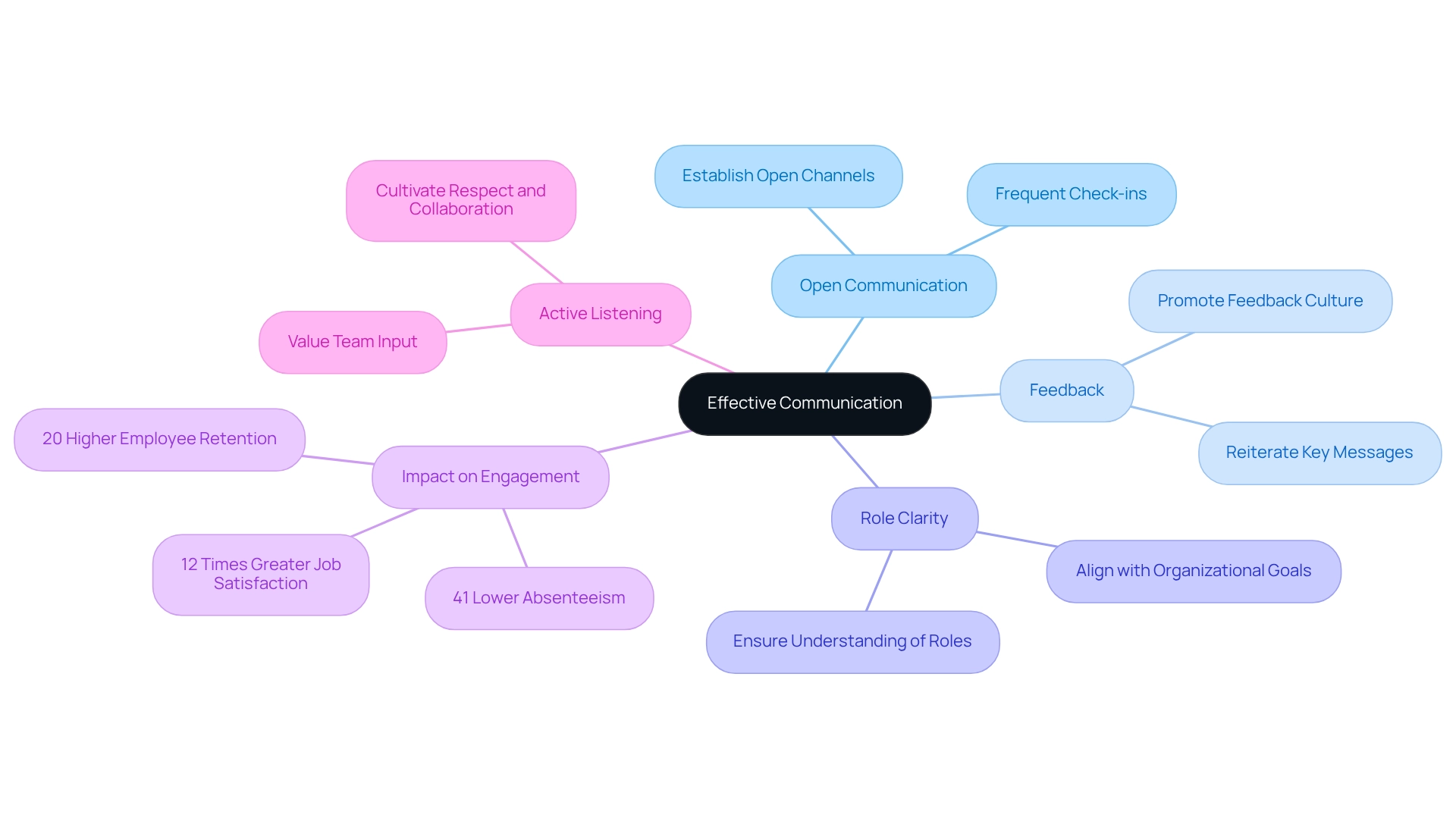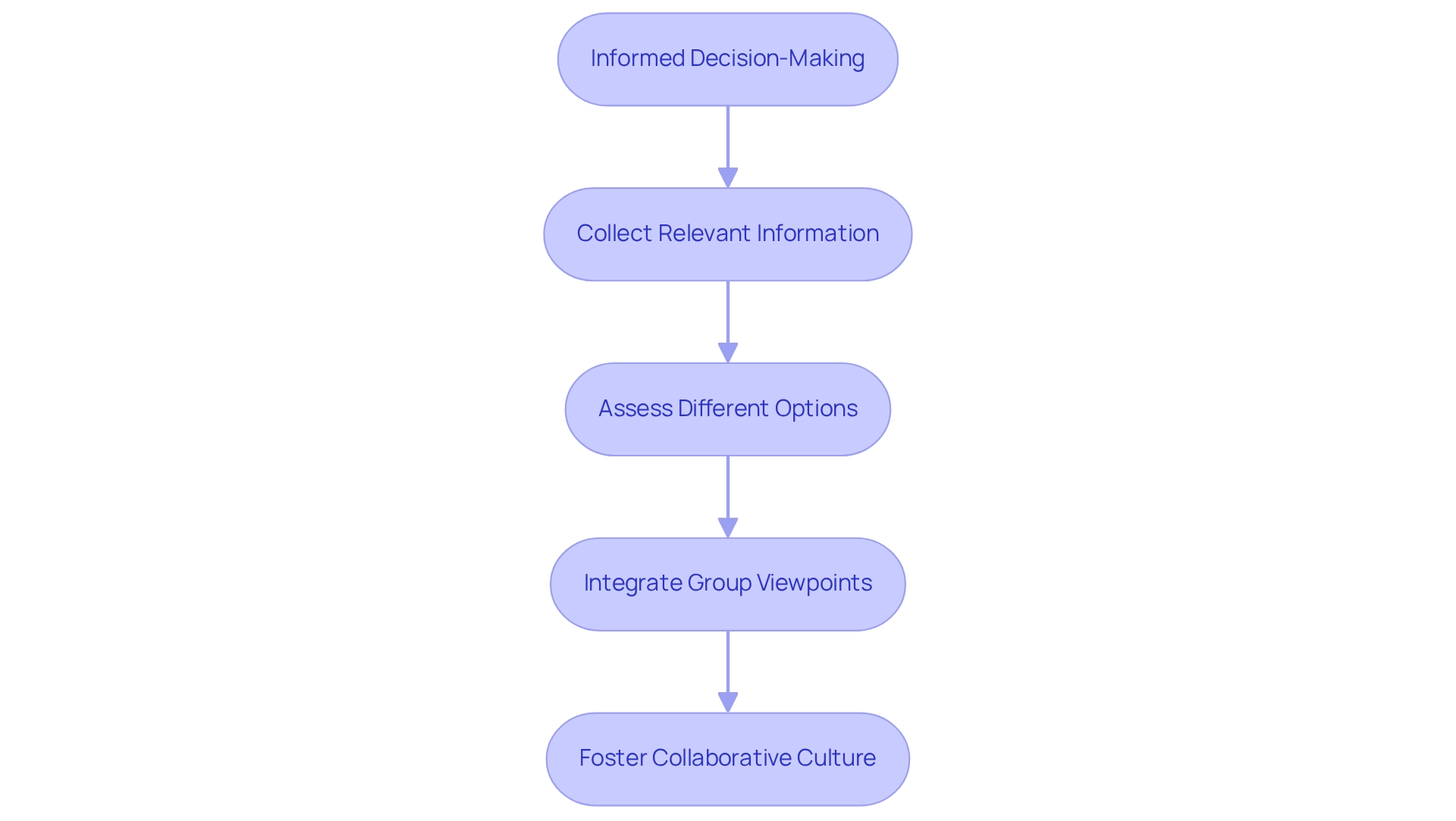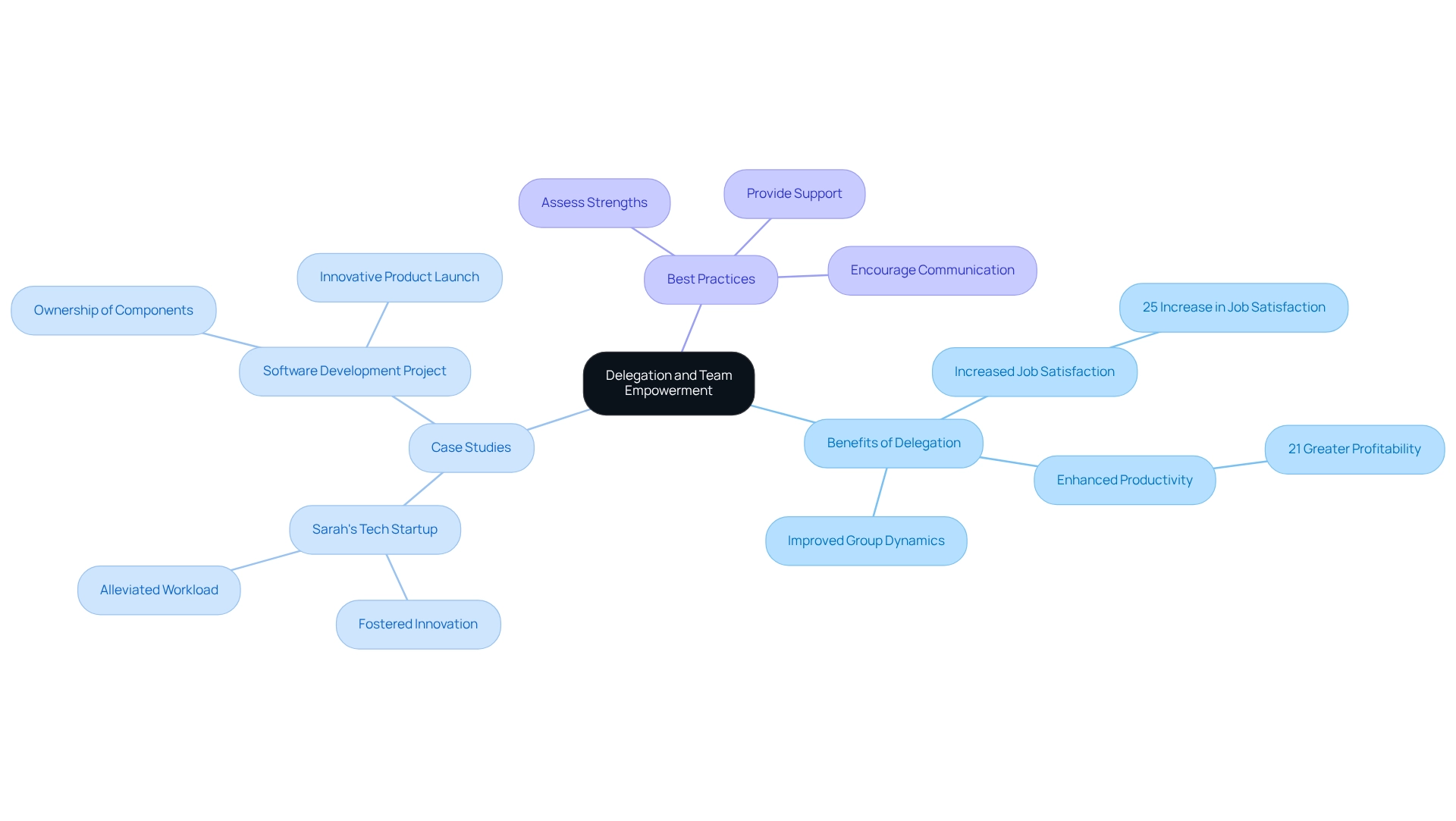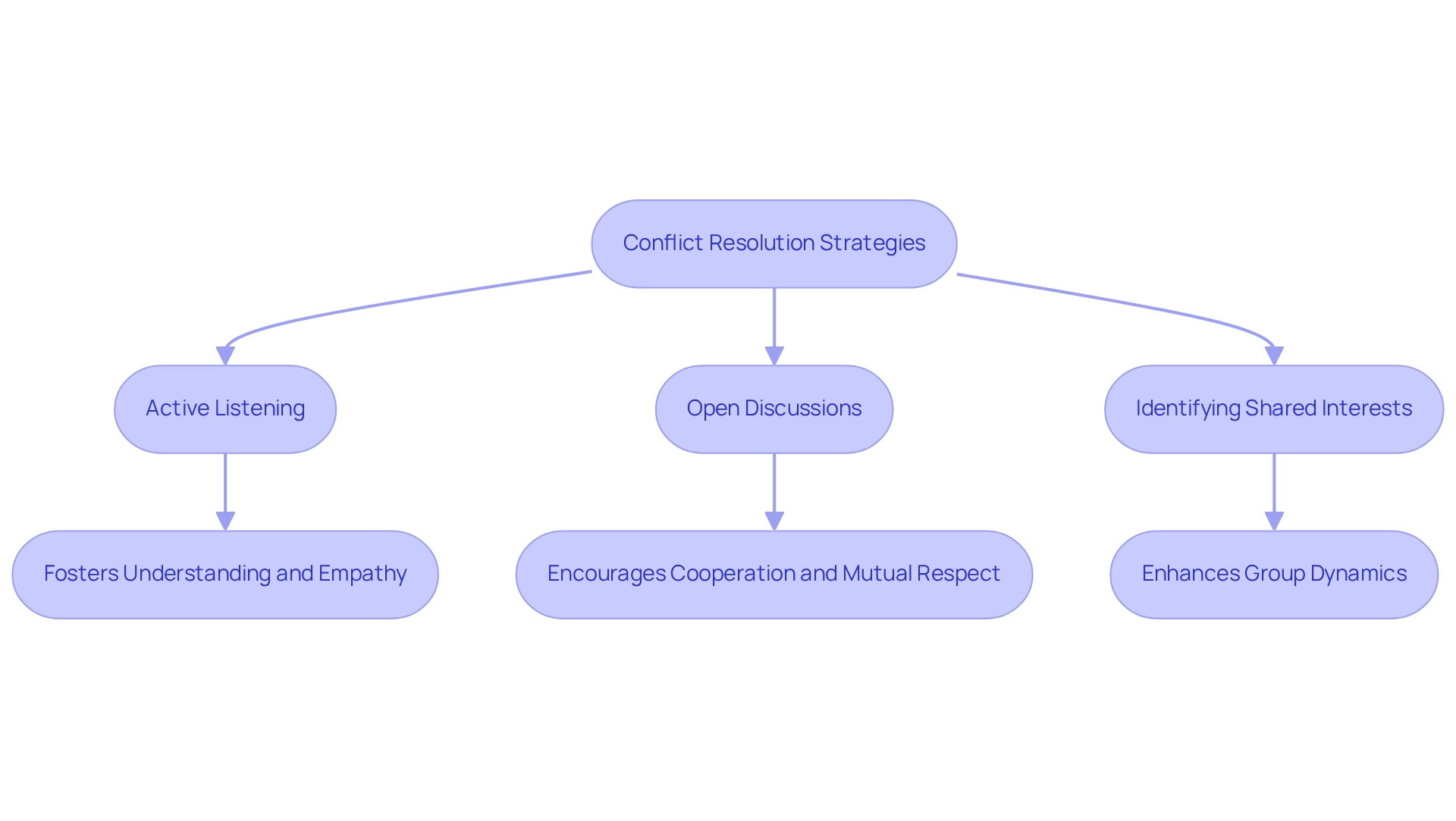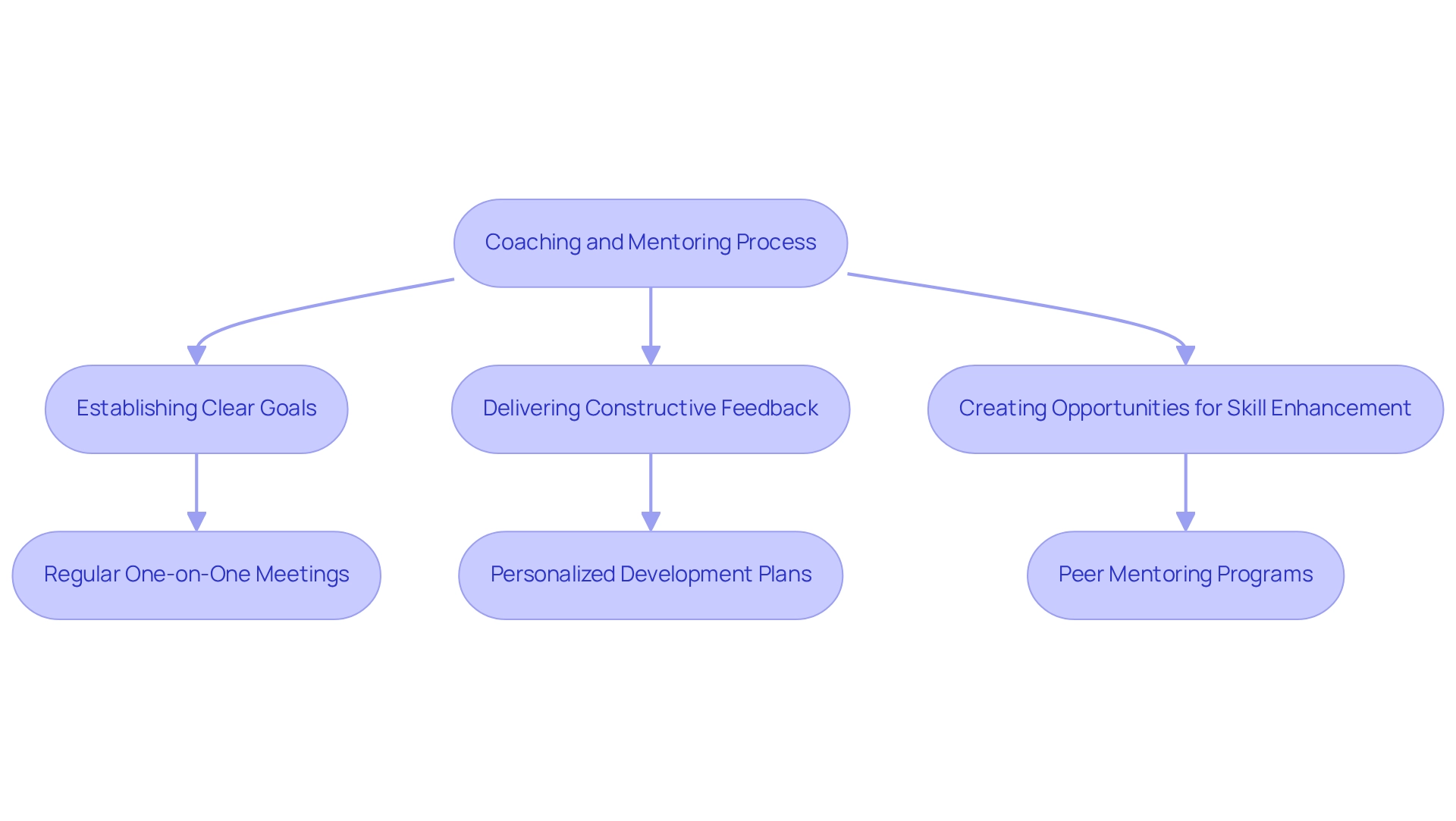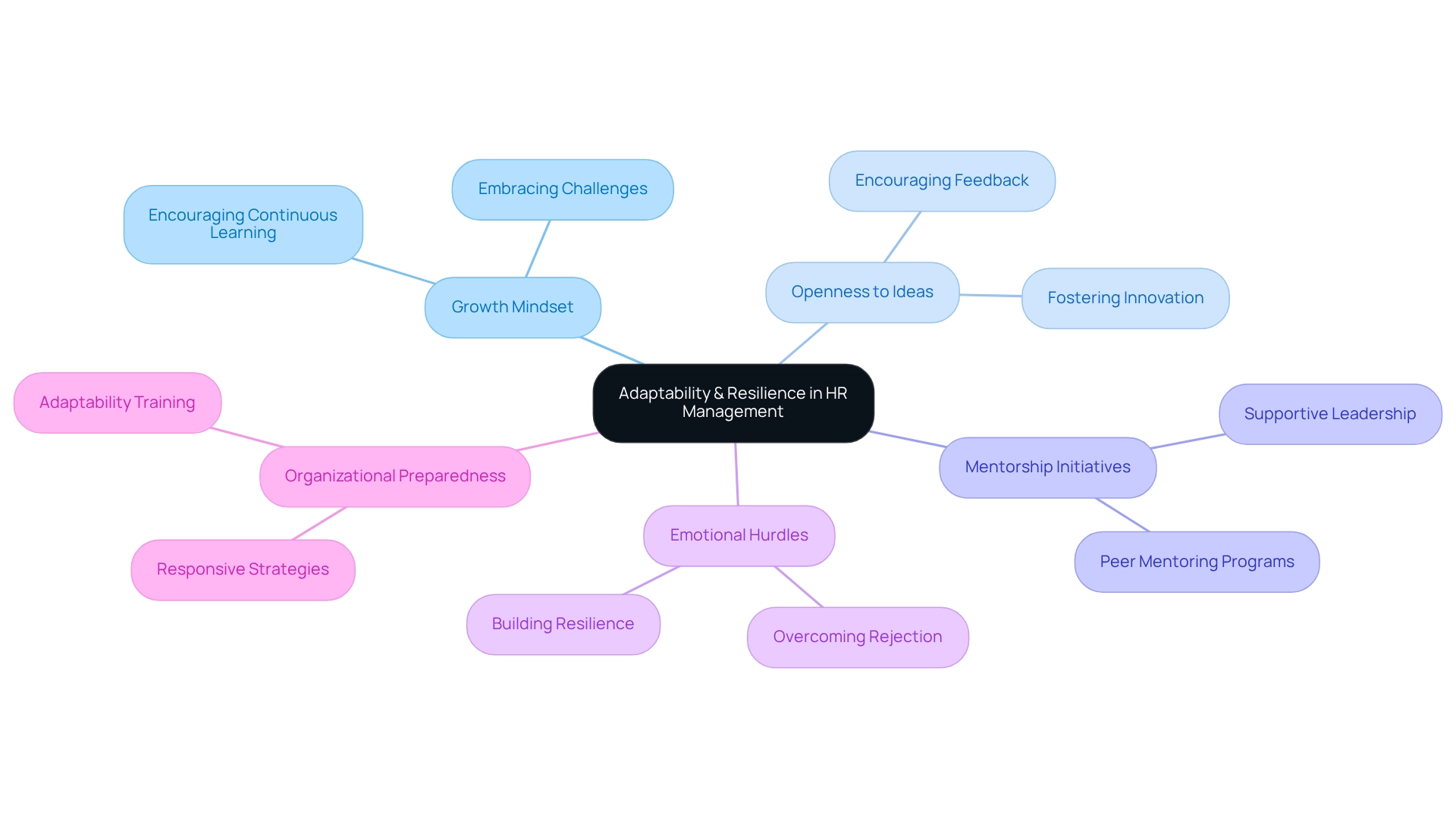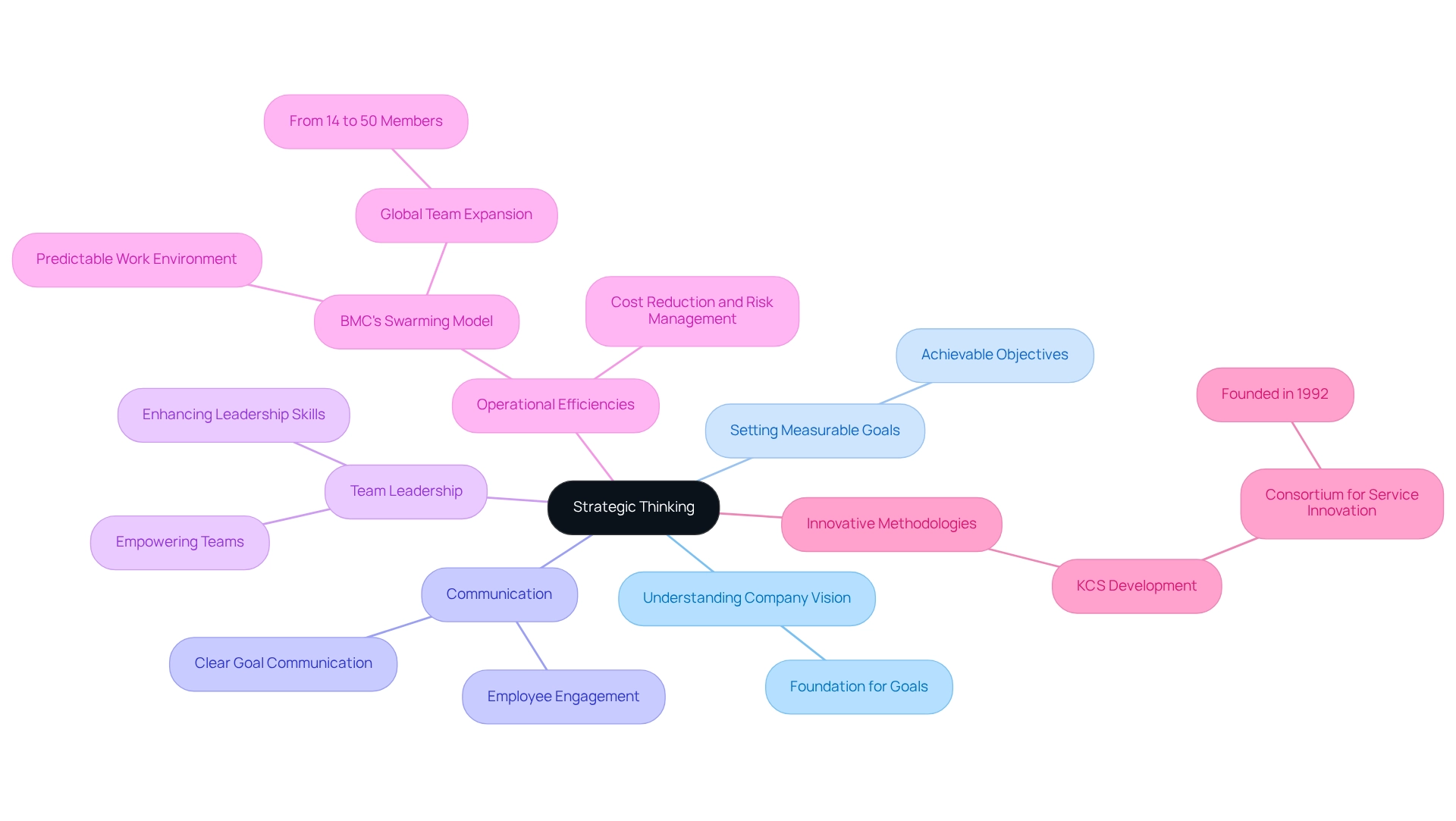Overview
The article identifies nine essential team leadership skills for HR managers, including emotional intelligence, effective communication, and adaptability. These skills are crucial for fostering strong team dynamics and achieving organizational goals. Each skill is supported by evidence and examples that demonstrate their impact on employee engagement, retention, and overall team performance. This highlights the importance of these competencies in effective HR management.
Key Highlights:
- Boutique Recruiting focuses on tailored recruitment solutions to align candidates with company culture, enhancing team leadership.
- Proactive talent acquisition teams are 50% more likely to value quality hires, crucial for effective recruitment.
- Emotional intelligence (EI) is essential for HR managers to foster supportive work environments and resolve conflicts.
- Training in EI significantly improves group dynamics, with over 90% of businesses recognizing its importance.
- Effective communication is vital for team alignment, leading to 41% lower absenteeism in engaged workplaces.
- HR managers should establish open communication channels and encourage feedback for improved productivity.
- Collaborative decision-making enhances employee buy-in and satisfaction, with 34% of employees leaving for better opportunities.
- Effective delegation empowers team members, with studies showing a 25% increase in job satisfaction from good delegation practices.
- Conflict resolution strategies, including active listening, improve team dynamics and foster cooperation.
- Coaching and mentoring are crucial for professional growth, requiring clear goals and constructive feedback.
- Time management strategies, such as setting deadlines and using tracking tools, enhance team productivity.
- Adaptability is essential for HR managers to navigate change and foster resilience in their teams.
- Strategic thinking helps align team goals with organizational objectives, improving overall performance and employee engagement.
Introduction
In the dynamic landscape of modern workplaces, effective team leadership is paramount. It hinges on a multifaceted approach that encompasses tailored recruitment, emotional intelligence, and strategic communication. As organizations strive to cultivate high-performing teams, understanding individual strengths, fostering collaboration, and implementing robust conflict resolution strategies are essential.
This article explores the critical skills and practices that HR managers must adopt to enhance team dynamics, drive engagement, and ensure alignment with organizational objectives. By examining the intersection of delegation, adaptability, and strategic thinking, we can see how these elements are vital in creating a resilient and motivated workforce capable of navigating the complexities of today’s business environment.
Boutique Recruiting: Tailored Recruitment Solutions for Effective Team Leadership
Boutique Recruiting excels in connecting high-quality candidates with employers by prioritizing a deep understanding of the unique needs of both parties. This tailored strategy enables HR managers to construct groups that not only possess the necessary skills but also fit harmoniously with the company culture, thereby enhancing team leadership skills and overall leadership effectiveness. By concentrating on tailored service, Boutique Recruiting allows organizations to pinpoint candidates who can greatly enhance positive group dynamics and team leadership skills.
Current trends indicate that proactive talent acquisition teams are 50% more likely to view the quality of hire as the most valuable metric, underscoring the importance of tailored recruitment strategies. Moreover, with 60% of businesses indicating a rise in their time-to-hire in 2024, the necessity for efficient and impactful recruitment solutions has never been more crucial. Boutique Recruiting’s tailored approach can help mitigate these challenges by streamlining the hiring process and ensuring that the right candidates are identified swiftly.
By incorporating expert insights, it is clear that a strong employer brand not only reduces hiring costs but enhances talent attraction and retention. As Kurt Vosburgh aptly states, “Your recruitment process is now a critical brand touchpoint,” emphasizing the necessity for HR leaders in boutique firms to comprehend the unique requirements of their organization to create strong groups.
Case studies reveal that 70% of employers cite employee engagement as key to retention, prompting the implementation of engagement platforms to monitor satisfaction. These platforms proactively address engagement concerns, ultimately fostering a healthier workplace culture and reducing turnover. Boutique Recruiting’s customized recruitment solutions play a crucial part in this process by ensuring that candidates not only meet the technical requirements but contribute positively to employee engagement and retention.
By utilizing these insights, Boutique Recruiting’s customized recruitment solutions are crucial for HR professionals seeking to foster team leadership skills effectively.
Emotional Intelligence: Cultivating Strong Workplace Relationships
Emotional intelligence (EI) encompasses the ability to recognize, understand, and manage one’s own emotions while also perceiving and influencing the emotions of others. As Mayer and Cobb state, it involves the perception, assimilation, understanding, and management of emotion. HR managers who demonstrate high levels of EI are pivotal in nurturing a supportive work atmosphere, fostering stronger connections among colleagues. This capability is essential for conflict resolution, employee motivation, and enhancing collaboration—crucial elements that contribute to effective team leadership skills within a group.
Training programs aimed at developing EI have been shown to significantly enhance group dynamics and overall performance. In fact, over 90% of businesses now recognize emotional intelligence as a critical factor for success in the workplace, particularly in aiding stress management and improving team leadership skills. This statistic underscores the growing acknowledgment of EI’s importance in HR practices. Executives possessing 10 to 12 emotional intelligence skills can improve their team leadership skills, allowing them to adjust their leadership styles more effectively and enhance group dynamics.
Furthermore, emotional intelligence plays a crucial role in establishing relationships, grasping group motivations, and making wise decisions. As highlighted in the case study ‘The Future of Emotional Intelligence in the Workplace,’ emotional intelligence is increasingly recognized as a critical factor for success, particularly in enhancing team leadership skills and aiding in stress management. As workplaces continue to evolve, the emphasis on EI in HR management becomes increasingly important, ensuring that leaders can navigate the complexities of human interactions and cultivate a unified group atmosphere.
While AI improves technical efficiency, it lacks the emotional understanding needed for people-related services, further emphasizing the necessity of emotional intelligence in effective HR management.
Effective Communication: Ensuring Clarity and Team Alignment
Effective communication is essential for conveying information clearly and fostering an environment where group members feel acknowledged. HR managers must prioritize the establishment of open communication channels, actively promote feedback, and ensure that every member comprehends their roles and responsibilities. Frequent check-ins and group meetings serve as vital tools in this process, as they not only align with organizational goals but also enhance overall productivity.
Data indicates that engaged workplaces experience 41% lower absenteeism compared to disengaged ones, underscoring the importance of robust communication in maintaining a motivated workforce. Furthermore, employees who benefit from clear business communication report 12 times greater job satisfaction than those in environments characterized by ineffective communication.
To illustrate the impact of communication on group dynamics, research conducted by Deloitte reveals that companies with a strong collaborative culture are 20% more likely to retain their employees. This retention is frequently associated with effective communication strategies that foster clarity and alignment.
Incorporating active listening into communication practices is equally vital. By genuinely valuing team members’ input, HR professionals can cultivate a culture of respect and collaboration, which is crucial for team alignment. As Gallup has found, supervisors significantly influence employee engagement, accounting for 70% of the variance between a good and mediocre workplace. This highlights the necessity for HR professionals to communicate effectively and engage their teams. Additionally, reiterating key messages through various channels is essential for ensuring employee awareness and action. Implementing these effective communication strategies not only bolsters group cohesion but also markedly enhances productivity, establishing team leadership skills as a fundamental competence for HR professionals aiming to lead successful teams. This approach will facilitate the creation of a more engaged and aligned workforce.
Decision-Making Skills: Navigating Complex Situations with Confidence
HR managers must excel in making informed decisions that consider both immediate and long-term implications for their groups. This process entails collecting relevant information, assessing different options, and integrating the viewpoints of group members. By fostering a culture of collaborative decision-making, HR leaders not only empower their groups but also enhance buy-in and improve overall results.
Statistics indicate that 34% of employees have departed from their former positions in pursuit of improved career advancement opportunities. This highlights the necessity for HR professionals to cultivate an atmosphere where team members feel appreciated and listened to. Moreover, expert views indicate that 83% of HR professionals acknowledge that training greatly assists in attracting talent, emphasizing the essential role of informed decision-making in developing effective recruitment strategies.
Boutique Recruiting exemplifies this meticulous approach by ensuring candidates meet both technical qualifications and cultural fit, which is essential for making informed hiring decisions. Their commitment to personalized talent acquisition solutions across diverse industries in the U.S. and Canada enhances the recruitment process, allowing HR managers to navigate the talent war effectively. Additionally, the emphasis on transparency and authenticity during interviews helps build trust and ensures that candidates are aligned with organizational values.
Case studies, such as IBM’s use of AI in workforce management, demonstrate the potential of advanced tools to predict employee turnover with 95% accuracy. This enables HR departments to implement proactive strategies that enhance retention and address employee dissatisfaction. This multifaceted method of decision-making not only enhances group dynamics but also showcases the team leadership skills of HR leaders as crucial figures in promoting organizational success.
Delegation: Empowering Team Members for Optimal Workflow
Delegation represents the strategic assignment of tasks to group members, leveraging their individual strengths and expertise. For HR managers, it is imperative to clearly outline expectations and provide the necessary resources to empower teams. This approach not only alleviates workloads but also fosters professional growth and advancement, showcasing team leadership skills that result in a more engaged and productive workforce, while effective delegation has been shown to significantly enhance group performance and morale. Groups that practiced effective delegation reported an impressive 25% increase in job satisfaction, highlighting how delegation can positively affect group dynamics and overall workplace satisfaction. This improvement is crucial, as engaged groups can achieve 21% higher profitability and productivity compared to their disengaged counterparts.
A compelling case study exemplifies this impact: Sarah, the CEO of a tech startup, implemented a delegation strategy to enhance collaboration and ownership by assigning key project tasks to her associates. This decision not only reduced her workload but also cultivated a culture of innovation, resulting in a 25% increase in job satisfaction among her team. Moreover, in a recent software development project at a leading tech company, delegation allowed team members to take ownership of specific components, culminating in an innovative product launch that outpaced competitors by six months. This demonstrates how effective delegation, along with strong team leadership skills, can empower group members, fostering both individual and collective achievement.
To maximize the benefits of delegation, HR leaders should adopt best practices such as:
- Regularly assessing group members’ strengths
- Providing ongoing support
- Encouraging open communication
By doing so, they can cultivate an environment where delegation not only boosts productivity but also enriches overall group dynamics. HR supervisors are encouraged to implement these strategies within their teams to experience the transformative effects of effective delegation.
Conflict Resolution: Maintaining Harmony in the Workplace
HR managers must be adept at implementing effective conflict resolution strategies to maintain group harmony. Active listening is a key approach, fostering understanding and empathy, while facilitating open discussions allows all parties to articulate their viewpoints. Identifying shared interests is essential in resolving disagreements, as it encourages cooperation and mutual respect among group members.
Cultivating a culture of respect and understanding not only assists in conflict resolution but also enhances overall group dynamics. Research indicates that 98 percent of participants recognize the importance of cultural intelligence in managing workplace conflicts, highlighting the necessity of integrating this skill into strategies such as active listening and open discussions. Furthermore, organizations that prioritize conflict resolution training frequently experience improved team performance, heightened motivation, and a more cohesive work environment.
For instance, a study revealed that over 50% of respondents acknowledged that well-managed conflict can yield positive outcomes, including enhanced creativity and stronger working relationships. In contrast, 24% of workers reported not experiencing any positive results from conflicts, underscoring the need for efficient conflict management strategies to mitigate negative experiences.
Incorporating expert opinions, such as those from conflict resolution specialists, can further empower HR professionals in crafting robust strategies. As noted by Thomas Crum, “The quality of our lives depends not on whether or not we have conflicts, but on how we respond to them.” By acquiring these essential team leadership skills, HR professionals can create a collaborative environment that is vital for effective leadership.
Coaching and Mentoring: Fostering Professional Growth and Development
HR managers play a crucial role in coaching and mentoring their colleagues, which is vital for promoting professional growth and developing team leadership skills. This process involves:
- Establishing clear goals
- Delivering constructive feedback
- Creating opportunities for skill enhancement
By prioritizing their group’s development, HR leaders not only enhance individual performance but also propel the overall success of the organization. As Albert Einstein wisely stated, “Learn from yesterday, live for today, hope for tomorrow,” highlighting the continuous nature of learning.
Bernard Kelvin Clive emphasizes that professional growth is primarily the responsibility of the individual, underscoring the importance of proactive learning and skill enhancement. Effective mentoring can significantly impact employee development and foster team leadership skills, leading to a more competent and motivated workforce.
In this context, leaders should adopt strategies such as:
- Regular one-on-one meetings
- Personalized development plans
- Peer mentoring programs
These strategies foster team leadership skills, encouraging continuous learning and adaptability to ensure that their groups are well-equipped to meet evolving challenges.
Time Management: Prioritizing Tasks for Team Success
Efficient time management is essential for HR managers aiming to prioritize tasks and enhance group productivity. By implementing strategies such as:
- Setting clear deadlines
- Breaking tasks into manageable segments
- Utilizing tracking tools
workflows can be significantly streamlined. A recent study revealed that the average time lost per person decreased from 1.64 hours in 2022 to just 1.25 hours in 2024, underscoring the positive impact of improved time management practices on overall productivity.
Fostering a culture of accountability and efficiency is paramount. By motivating group members to collaborate and share knowledge, as demonstrated in a case study with BMC Software, HR leaders can enhance communication and issue management capabilities. This initiative not only boosted employee morale but also led to greater customer satisfaction, illustrating how effective time management practices—such as regular check-ins and collaborative problem-solving—can directly contribute to group success.
Moreover, tools like Asana can aid in managing tasks, prioritizing effectively, and visualizing workloads through calendar integration. For instance, a financial firm adopted Asana to track project deadlines and assign tasks, resulting in a 20% increase in on-time project completion. By embracing these time management techniques, HR leaders can ensure their teams remain focused and productive, ultimately driving organizational success.
Adaptability: Responding to Change with Resilience
HR managers must prioritize adaptability within their groups to excel in today’s ever-evolving work landscape. This entails fostering a growth mindset, encouraging openness to new ideas, and viewing change as a catalyst for improvement. By instilling resilience, HR leaders empower their groups to effectively navigate challenges and sustain high performance. As Eric Eddy noted, the firm’s ability to deliver top-notch candidates quickly and efficiently underscores the necessity of adaptability in HR management. Organizations that implement adaptability training for HR groups in 2025 are better equipped to respond to shifting market demands and internal dynamics.
Consider the journey of an aspiring musician who faced multiple rejections before gaining acceptance into prestigious graduate programs. This experience underscores the emotional hurdles and the vital role of resilience in achieving success, echoing Thomas Edison’s sentiment that our greatest weakness lies in giving up. Moreover, organizations that actively foster resilience in their workforce—such as through mentorship initiatives and supportive leadership—exhibit improved group cohesion and performance. Resilience not only results in wisdom, courage, and strength when confronting challenges but is also crucial for HR leaders to cultivate among their groups.
Expert views highlight that flexibility is not merely a valued quality but a requirement in HR management, allowing groups to flourish in the face of uncertainty and change. How prepared is your organization to adapt to these demands? It is time to embrace adaptability and resilience as core competencies in your HR strategy.
Strategic Thinking: Aligning Team Goals with Organizational Objectives
HR managers must prioritize strategic thinking to effectively align their group’s goals with the overarching objectives of the organization. This process begins with a deep understanding of the company’s vision, serving as a foundation for setting measurable and achievable goals. Clear communication of these goals to group members is essential; it fosters a shared sense of purpose and direction. By cultivating a strategic mindset, HR leaders enhance their team leadership skills, empowering their teams to contribute significantly to the organization’s success and improving overall performance and cohesion. This alignment not only drives productivity but also enhances employee engagement, ultimately resulting in better organizational outcomes.
Incorporating strategic thinking can lead to operational efficiencies, as exemplified by BMC’s approach to service management, which helps organizations cut costs and reduce risks. Patrick Gay, Lead TSA at BMC, remarked, “I knew the group was on to something good when I saw the employee morale improve. It is a leading indicator of customer loyalty and productivity.” This statement underscores the tangible advantages of aligning group goals with organizational objectives.
A practical example of this can be found in BMC Software’s swarming model, which created a more predictable work environment for Support Analysts. This model, which expanded from 14 to a global group of 50, allowed analysts to concentrate on their tasks without frequent interruptions, thereby enhancing focus and efficiency. Furthermore, the Consortium for Service Innovation has been pivotal in developing innovative methodologies like KCS since 1992, showcasing the evolution of strategic thinking in the support industry. By leveraging these insights, HR managers can adopt innovative approaches to improve their team leadership skills and align their teams effectively with organizational goals.
Conclusion
Effective team leadership in today’s workplace necessitates a comprehensive understanding of critical skills and practices that HR managers must embrace. Tailored recruitment strategies, underscored by Boutique Recruiting, ensure that candidates not only meet technical qualifications but also resonate with the company culture, thereby enhancing team dynamics and leadership effectiveness. Emotional intelligence stands out as a vital component, empowering HR leaders to cultivate strong workplace relationships and adeptly resolve conflicts, which is essential for sustaining a collaborative environment.
Furthermore, effective communication is pivotal in ensuring team alignment and productivity. By fostering an atmosphere of openness and feedback, HR managers can significantly enhance employee engagement and satisfaction. Decision-making skills further empower HR leaders to navigate complex situations, enabling informed choices that consider both immediate and long-term implications for their teams.
Delegation and conflict resolution strategies are equally crucial, as they promote professional growth and maintain harmony within the workplace. Coaching and mentoring initiatives foster individual development, while effective time management practices streamline workflows and bolster productivity. Adaptability remains essential for teams to thrive amidst change, reinforcing the need for HR managers to cultivate resilience and a growth mindset.
Ultimately, strategic thinking is paramount in aligning team goals with organizational objectives, driving productivity and employee engagement. By integrating these principles and practices, HR managers can create high-performing teams that are not only resilient but also equipped to tackle the complexities of the modern business landscape. Embracing this multifaceted approach will lead to enhanced team dynamics, higher engagement levels, and alignment with organizational success.
Frequently Asked Questions
How does Boutique Recruiting connect candidates with employers?
Boutique Recruiting excels in connecting high-quality candidates with employers by prioritizing a deep understanding of the unique needs of both parties, enabling HR managers to construct teams that possess the necessary skills and fit harmoniously with the company culture.
What is the significance of tailored recruitment strategies?
Tailored recruitment strategies are significant as they enhance the quality of hire, which is viewed as the most valuable metric by 50% of proactive talent acquisition teams. They also help organizations streamline the hiring process and swiftly identify the right candidates.
How does Boutique Recruiting address the challenges of increased time-to-hire?
Boutique Recruiting’s tailored approach helps mitigate challenges related to increased time-to-hire by streamlining the hiring process and ensuring that the right candidates are identified quickly.
What role does emotional intelligence (EI) play in HR management?
Emotional intelligence is crucial in HR management as it involves recognizing, understanding, and managing emotions, which fosters a supportive work atmosphere, enhances collaboration, and aids in conflict resolution, all of which contribute to effective team leadership skills.
Why is emotional intelligence recognized as critical for success in the workplace?
Over 90% of businesses recognize emotional intelligence as a critical factor for success, particularly in stress management and improving team leadership skills, highlighting its importance in HR practices.
What impact does effective communication have on employee engagement?
Effective communication leads to engaged workplaces, which experience 41% lower absenteeism and significantly higher job satisfaction. Companies with strong collaborative cultures are also 20% more likely to retain their employees, underscoring the importance of robust communication.
How can HR managers promote effective communication within teams?
HR managers can promote effective communication by establishing open channels, actively promoting feedback, conducting frequent check-ins, and ensuring that every member understands their roles and responsibilities.
What is the relationship between communication and productivity?
Implementing effective communication strategies not only enhances group cohesion but also markedly improves productivity, establishing team leadership skills as a fundamental competence for HR professionals.
